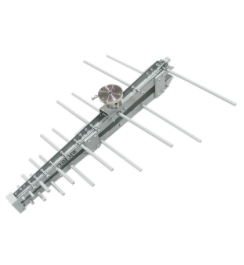Principle of dual polarization antenna
Dual polarization antenna

There are two other cases of single polarization:+45 ° polarization and -45 ° polarization, which are only used in special situations.
In this way, there are four types of monopolarization, as shown in the following figure. Combining antennas with both vertical and horizontal polarization, or By combining antennas with+45 ° polarization and -45 ° polarization, a new type of antenna - a dual polarization antenna - is formed. Note that a dual polarized antenna has two joints. The dual polarized antenna radiates (or receives) waves that are orthogonal (perpendicular) to each other in space.
Antenna polarization loss
Vertical polarized waves should be received using antennas with vertical polarization characteristics, while horizontal polarized waves should be received using antennas with horizontal polarization characteristics. Right-handed circularly polarized waves need to be received by antennas with right-handed circularly polarized characteristics, while left-handed circularly polarized waves need to be received by antennas with left-handed circularly polarized characteristics.
When the polarization direction of the incoming wave is inconsistent with the polarization direction of the receiving antenna, the received signal will decrease, which means polarization loss occurs. For example, when using a+45 ° polarized antenna to receive vertically polarized or horizontally polarized waves, or when using a vertical polarized antenna to receive+45 ° polarized or -45 ° polarized waves, polarization loss occurs. Using a circularly polarized antenna to receive any linearly polarized wave, or using a linearly polarized antenna to receive any circularly polarized wave, and so on, will inevitably result in polarization loss - only half of the energy of the incoming wave can be received.
When the polarization direction of the receiving antenna is completely orthogonal to the polarization direction of the incoming wave, for example, when a horizontally polarized receiving antenna receives a vertically polarized incoming wave, or when a right-handed circularly polarized receiving antenna receives a left-handed circularly polarized incoming wave, the antenna cannot receive the energy of the incoming wave at all. In this case, the polarization loss is the maximum, which is called complete polarization isolation.
Antenna polarization isolation
There is no ideal polarization complete isolation. The signal fed into one polarized antenna will always have a slight appearance in another polarized antenna. For example, in the dual polarization antenna shown in the figure below, if the power input to the vertically polarized antenna is 10W, the output power measured at the output end of the horizontally polarized antenna is 10mW.
Input impedance of antenna Zin
Definition: The ratio of signal voltage to signal current at the antenna input end is called the input impedance of the antenna. The input impedance has a resistance component Rin and a reactance component Xin, that is, Zin=Rin+j Xin. The presence of reactance components will reduce the extraction of signal power by the antenna from the feed line. Therefore, it is necessary to make the reactance component as zero as possible, which means that the input impedance of the antenna should be pure resistance as much as possible. In fact, even well designed and debugged antennas always contain a small reactance component value in their input impedance.
The input impedance is related to the structure, size, and working wavelength of the antenna. The half wave symmetric oscillator is the most important basic antenna, with an input impedance of Zn=73.1+j42.5 (ohms). When the length of the antenna is shortened by (3-5)%, the reactance component can be eliminated, making the input impedance of the antenna pure resistance. At this time, the input impedance is Zin=73.1 (ohms), (nominal 75 ohms).
Note that strictly speaking, the input impedance of a purely resistive antenna is only for point frequency.
By the way, it should be pointed out that the input impedance of the half wave equivalent oscillator is four times that of the half wave symmetric oscillator, which is Zin=280 (ohms) (nominal 300 ohms).
It is interesting that for any antenna, people can always adjust the antenna impedance to make the imaginary part of the input impedance very small and the real part quite close to 50 ohms within the required operating frequency range, so that the input impedance of the antenna is Zin=Rin=50 ohms - this is necessary for the antenna to have a good impedance match with the feed line.





